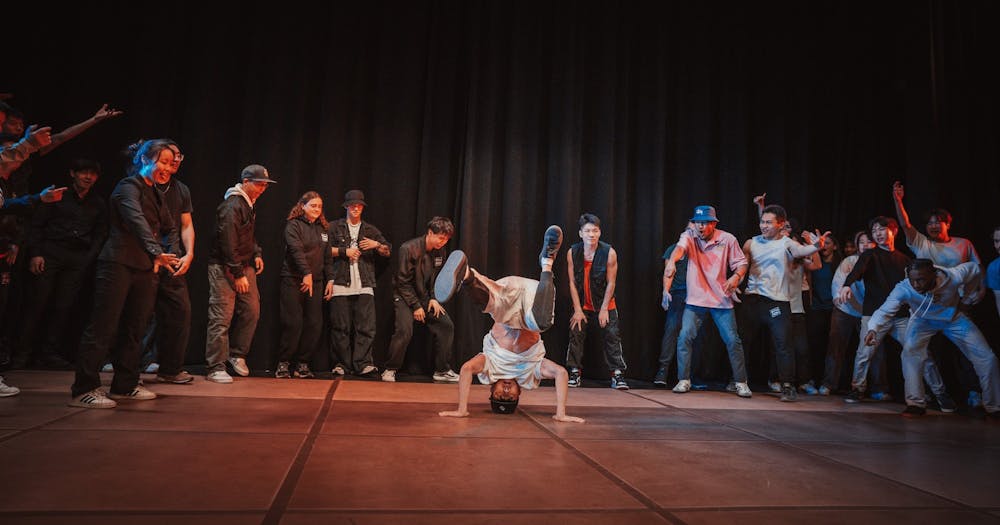On a bustling Friday night, I was surrounded by an intoxicating energy in Frist Theatre, where Sympoh, Princeton’s only B-Boy/B-Girl (break-boy/break-girl) crew, was performing.
A rumbling current of enthusiasm shook the room. People roared in anticipation of seeing Sympoh’s spring-semester production, “Beat Kill”: a showcase of bold, electrifying performances that both embodied the essence of breakdancing and challenged its conventions through freestyle. Hip-hop and alternative dance blended, forming the basis for locking, dropping, and other moves.
The lights dimmed and the trailer began, augmenting the excitement with a murder-mystery skit, starting the storyline in a playful opening. The main show then began. In each set, the dancers presented a unique style through dynamic moves. These movements, fashionably compiled, yielded thrilling, captivating acts of break-dancing. Intense spurts of dance illuminated by fiery floodlights alternated with moodier formations. Some pieces displayed mellower, expressive auras while others spotlighted valiant, vigorous grunge.
“We punned on the phrase ‘killing the beat,’ which describes a dancer who is completely in sync with the music,” said co-presidents Hank Lin ’24 and Tuan Dinh ’25 in reference to the concept of the show.
Although the theme revolved around a murder-mystery parody, it did not dictate the pieces that were performed. Rather, its storyline fitted into the fillers between pieces. Lin and Dinh explained that this choice “allowed [their] choreographers and casts to have creative freedom.” The placement of the parody motif both allowed company members to craft their individual styles and maintain enthrallment throughout the show. The light-hearted satire provided transitions between the awe-inducing Windmills, Baby Freezes, and Air Freezes, classic break-dance moves present throughout every dance.
Hip-hop and break-dancing were central to the night, but influences of martial arts and gymnastics also surfaced. The choreography reflected the mosaic of dance styles and interpretations that the dancers wanted to honor by incorporating them in the rap-centric pieces. Every spin and shuffle provoked amazement. Each leg swing, torso sway, and boisterous jump possessed power. Dexterity of the hand motions, intricacy of the footwork, and sharpness of the movements highlighted suave, groovy energy.
The end featured a performance that began as a spirited rendition of Mariah Carey’s “All I Want for Christmas Is You” but eventually evolved as each dancer improvised their own funky moves to auto-tuned emo rap. Tying together the best of freestyle and break-dance, this choreography is what I learned was known as the Bread Piece.
Lin and Dinh clarified that the Bread Piece is a Sympoh tradition that “allows people to just enjoy themselves and participate in a choreography that’s not really meant to be executed perfectly, but to give the audience something to laugh about.” They elaborated, saying, “Bread Piece represents a prime aspect of Sympoh: no matter how hard we work, we always make sure to have fun as well.”
Further, it was evident that strong sentiments of passion reigned throughout the production. Every breaker (jargon for an individual who break-dances) reciprocated each other’s energy and excitement. Each move was executed with vitality and vigor. They were absorbed in the hype of the environment.
As the only no-cut, no-audition dance group on campus, Sympoh takes pride in this differentiating virtue that creates a prevalent sense of camaraderie. “Starting from nothing, we all help each other grow as dancers during laid-back seshes that really feel like you’re just hanging out with friends while trying to throw a cool move that you learned about,” said Lin and Dinh. They further articulated how their relaxed practice culture “along with the freestyle nature of break-dance itself, are things that [they] feel have helped us develop relationships with each other that keep alums from even decades ago coming back.”
Sympoh has become a place for students to integrate into the Princeton community. As Kevin Rosales ’26, my friend and fellow zee who joined the company this past semester, proclaimed, “Sympoh is more than just a dance group — it’s a group of friends here at Princeton.” Essentially, Sympoh is a close-knit family that has “made [the] experience at Princeton a lot more of an easy and enjoyable experience to transition into,” according to Rosales.
After one of the fillers, Rosales was encouraged by upperclassmen members to join them on stage for the freestyle segment, despite not being part of the official lineup of the show. Company members who were initially spectators for the night soon became active performers. At one point, Rosales showed off impressive moves in the center of the semi-circle huddle, which consisted of the entire dance company.

“It was very gratifying to be able to show off what I have been practicing since the beginning of my freshman year to both my peers and those in the audience,” Rosales remarked. “It overall encapsulated feelings of genuine thrill, adrenaline, and most of all, fun,” he added.
I’ve been to other dance shows before. I’ve never seen one where members in the audience are pulled onto stage and put everything they have into expressing themselves as B-Boys and B-Girls, as Rosales did that Friday night. Amidst the hype of the dynamic break-dancing, there is a strong pillar of comradeship that drives the group, galvanizing the passion of every piece and performer.
Sympoh bled energy and comradery: qualities that personify the company as one big, vivacious family.
Russell Fan is an assistant editor for The Prospect at the ‘Prince.’ He can be reached at rf4125@princeton.edu, or on Instagram @russell__fan.
Please send corrections to corrections[at]dailyprincetonian.com.








